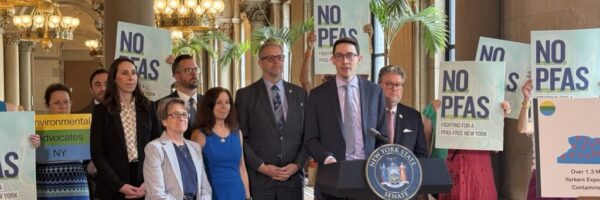
“How can this happen?” Fight over sewage sludge on farms intensifies
By Marin Scotten
Ryan Dunham heard his eleven-year-old daughter’s scream from his living room. He bolted up the stairs to the bathroom where she was taking a shower and couldn’t believe his eyes. The water flowing from the faucet was brown, and it smelled like “decay, rot and death.”

New evidence of chlorpyrifos harm to kids’ brains amid regulatory retreat
By Brian Bienkowski
Children highly exposed to an insecticide prior to birth showed signs of impaired brain development and motor function, according to a new study of chlorpyrifos — a pesticide still used on US crops despite decades of warnings about its impact on children’s health.

Federal judge rules to restore some USDA grants for farmers and underserved communities
By Shannon Kelleher
A federal judge this week ruled that the Trump administration’s move to terminate several grants to support farmers and underserved communities was likely “arbitrary and capricious,” and ordered the US Department of Agriculture (USDA) to restore five grants it canceled and cease the cancellation of a sixth grant.

Federal judge sees “urgency” in Maryland PFAS contamination claims
By Shannon Kelleher
A federal judge this week said that a group of Maryland residents could proceed with a class action lawsuit against Perdue Farms that alleges the company’s soybean plant improperly discharged harmful chemicals that contaminated their well water, but dismissed claims seeking to link the contamination to residents’ existing medical ailments.

Syngenta closer to settling thousands of US paraquat lawsuits
By Carey Gillam
Syngenta is another step closer to potentially putting an end to thousands of lawsuits brought by people blaming the company’s paraquat weed killer for causing Parkinson’s disease.
WATCH: Cancer and water contamination fuel public outcry in Iowa
Hundreds of Iowans gathered at Drake University in early August to confront a growing water quality crisis linked to the state’s powerful agricultural industry. Community leaders, scientists and farmers warned of dangerously high levels of nitrates, pesticides and livestock waste contaminating the state’s drinking water.

Study maps factory farm hotspots as federal court tosses emissions lawsuit
By Brian Bienkowski
Roughly a quarter of the nation’s large cattle, dairy and hog farms are located in just 30 US counties, a new satellite-mapping study has found. The research also links large farms — whether in these dense hotspots or scattered elsewhere — to elevated air pollution.

Outrage in Iowa – Residents demand action to clean up dangerously polluted water
By Carey Gillam
DES MOINES, Iowa- Several hundred Iowa residents gathered in the state capital this week, calling on public officials – and each other – to take swift action against dangerously polluted water supplies that are closely linked to the state’s powerful agricultural industry.

New report calls plastics a “grave” danger to health as nations negotiate treaty
By Brian Bienkowski
Plastics are a “grave” danger to humans and the planet, responsible for an estimated $1.5 trillion annually in health-related costs, and nations need to center human health as they finalize the global plastics treaty, scientists said in a new report released Monday.
WATCH: AI at what cost? Environmental concerns over Trump’s new action plan
The Trump administration’s new AI action plan aims to make the US a leader in developing and deploying the technology. This sweeping proposal would fast-track AI development by exempting data centers from environmental protections. It may also increase reliance on fossil fuels. Experts warn it could strain US water and power supplies, deepen pollution in vulnerable communities and sideline clean energy.